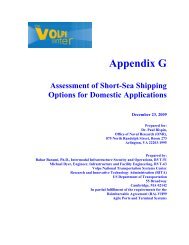ERRV Viking Islay - Marine Accident Investigation Branch
ERRV Viking Islay - Marine Accident Investigation Branch
ERRV Viking Islay - Marine Accident Investigation Branch
- No tags were found...
Create successful ePaper yourself
Turn your PDF publications into a flip-book with our unique Google optimized e-Paper software.
<strong>Viking</strong> <strong>Islay</strong>’s risk assessment for tank/space entry had several errors, including amismatch between the risk assessment and the equipment actually available onboard. For example, the control measures mention ventilating the space, but nottesting the atmosphere. The document was marked BUE <strong>Viking</strong> Ltd 2003. The SMSrisk assessment did not tally with the enclosed/confined space rescue checklist, whichspecifically required that the atmosphere be tested (Annex C).1.13.3 Toolbox-talk Risk Identification Card (TRIC)TRIC was an “offshore” work system, adopted as an additional safety measure byVroon and other offshore operators, which aimed to make the generic risk assessmentappropriate for a particular job, on a particular day. The process formalised the‘toolbox-talk’ by identifying hazards not covered by the risk assessment, along withany control measures required, and recorded them on the TRIC. A card was requiredto be completed for any non-routine task or when there had been any change to theplanned work scope. It was Vroon’s intention that as a final safeguard, the master’ssignature on the TRIC was required before work commenced. However, the format ofthe TRIC, and the associated instructions within the Vroon SMS, did not make this stepcompletely clear.In an attempt to make the system effective, Vroon had provided its fleet with guidanceon how many TRICs it expected to be completed monthly. On board <strong>Viking</strong> <strong>Islay</strong>, thishad been interpreted as a “target”, resulting in the cards being completed for arguablynon hazardous operations such as transferring food from the ship’s store rooms to thegalley. However, a TRIC was not completed for the entry into the chain locker.Another sign that completion of the TRIC was treated as an administrative functionrather than an important safety tool was that the master was signing them on a routinebasis, instead of signing the cards as they were compiled and before the relevant taskwas undertaken.1.13.4 Permit to Work systemA valid risk assessment must be in place before a PTW can be granted. The VroonSMS stated that the master or responsible officer had the overall responsibility forensuring that PTW forms were completed before any work was carried out.The responsible officer issuing the permit had to complete all sections, and then signthe certificate of checks. In order to comply with the terms of the PTW, the responsibleofficer would have to visit the work site.1.13.5 Internal vessel auditStaff from the Vroon Heath, Safety and Environment department carried out an internalaudit of <strong>Viking</strong> <strong>Islay</strong> on 1 March 2007. Safe working practices and the PTW systemwere reported as satisfactory, as was the ship’s emergency preparedness.1.13.6 Safety coachesVroon employed two safety coaches who were ex-seafarers, specifically to go to seaon board their ships in order to evaluate onboard practices and identify improvementswhere applicable. The coaches had managed to spend significant periods of time onboard the majority of the Vroon fleet. Vroon records show no coaching visits to <strong>Viking</strong><strong>Islay</strong> prior to the accident.23
















